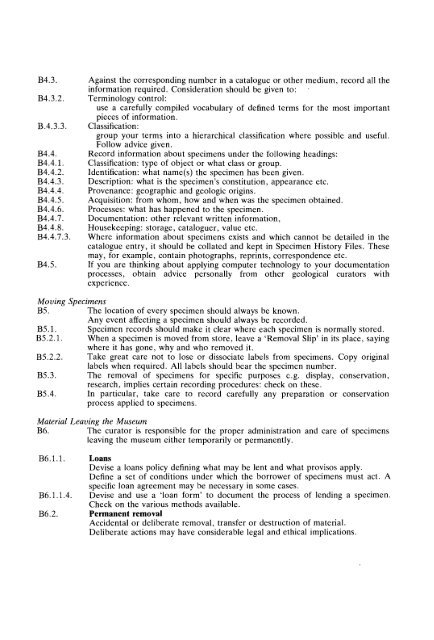GUIDELINES FOR THE CURATION OF GEOLOGICAL MATERIALS
GUIDELINES FOR THE CURATION OF GEOLOGICAL MATERIALS
GUIDELINES FOR THE CURATION OF GEOLOGICAL MATERIALS
Create successful ePaper yourself
Turn your PDF publications into a flip-book with our unique Google optimized e-Paper software.
Against the corresponding number in a catalogue or other medium, record all the <br />
information required. Consideration should be given to: . <br />
Terminology control: <br />
use a carefully compiled vocabulary of defined terms for the most important<br />
pieces of information.<br />
Classification:<br />
group your terms into a hierarchical classification where possible and useful.<br />
Follow advice given.<br />
Record information about specimens under the following headings: <br />
Classification: type of object or what class or group. <br />
Identification: what name(s) the specimen has been given. <br />
Description: what is the specimen's constitution, appearance etc. <br />
Provenance: geographic and geologic origins. <br />
Acquisition: from whom, how and when was the specimen obtained. <br />
Processes: what has happened to the specimen. <br />
Documentation: other relevant written information, <br />
Housekeeping: storage, cataloguer, value etc. <br />
Where information about specimens exists and which cannot be detailed in the <br />
catalogue entry, it should be collated and kept in Specimen History Files. These <br />
may, for example, contain photographs, reprints, correspondence etc. <br />
If you are thinking about applying computer technology to your documentation <br />
processes, obtain advice personally from other geological curators with <br />
experience. <br />
Moving Specimens<br />
B5. The location of every specimen should always be known.<br />
Any event affecting a specimen should always be recorded.<br />
B5.1. Specimen records should make it clear where each specimen is normally stored.<br />
B5.2.1. When a specimen is moved from store, leave a 'Removal Slip' in its place, saying<br />
where it has gone, why and who removed it.<br />
B5.2.2. Take great care not to lose or dissociate labels from specimens. Copy original <br />
labels when required. All labels should bear the specimen number. <br />
B5.3. The removal of specimens for specific purposes e.g. display, conservation, <br />
research, implies certain recording procedures: check on these.<br />
B5.4. In particular, take care to record carefully any preparation or conservation<br />
process applied to specimens.<br />
Material Leaving the Museum<br />
B6. The curator is responsible for the proper administration and care of specimens<br />
leaving the museum either temporarily or permanently.<br />
B6.1.1.<br />
B6.1.1.4.<br />
B6.2.<br />
Loans<br />
Devise a loans policy defining what may be lent and what provisos apply.<br />
Define a set of conditions under which the borrower of specimens must act. A<br />
specific loan agreement may be necessary in some cases.<br />
Devise and use a 'loan form' to document the process of lending a specimen.<br />
Check on the various methods available.<br />
Permanent removal <br />
Accidental or deliberate removal, transfer or destruction of material. <br />
Deliberate actions may have considerable legal and ethical implications.

















